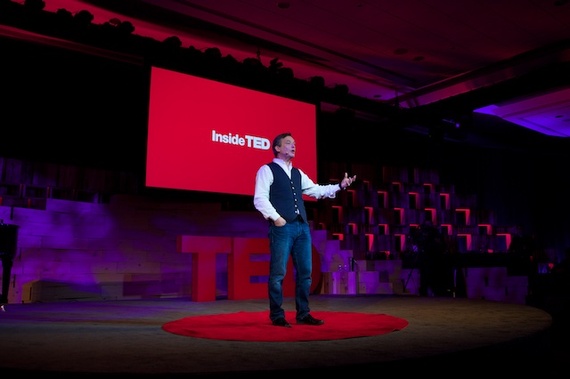Chris Anderson is a brit. Smart, cerebral, and a bit shy actually. Which is why his journey as the head of TED makes for extraordinary reading. His thinking, his evolution, and his emerging leadership in the world of spoken word storytelling is in turns both inspirational and remarkably useful.
But let's start with some history that Anderson shares about his acquisition of TED, and the growth of the community and the mission under his leadership.
It was late 2001 when Anderson purchased the TED conferences from its colorful founder Richard Saul Wurman. As he reveals in the book, "I was reeling from the near collapse of the company I had spent fifteen years building and was terrified of another huge public failure." This was four years before a TED Talk would be shared on the internet. In February of 2002 he stood on the stage in Monterey and had 14 minutes to make his case in front of eight hundred TEDsters - most of whom had resigned themselves to the fact that on Wurman's departure, the conference's days would be numbered. By his own admission the talk was awkward, full of um's and ah's - but it was passionate, honest, funny at points - and came from the heart. Jeff Bezos was the first person to stand, applaud, and embrace the future of TED under Anderson. Had the talk failed, had he not connected - TED would have faltered.
In Anderson's new book TED Talks: The Official TED Guide To Public Speaking (HMH/May 2016) he looks back at more than a decade of talks and dissects the critical elements that create the magical connection between speaker and audience member. It's not a formula, as the book makes clear. Instead, it's a detailed list of promises that speakers make and must deliver on.
A Gift In Every Great Talk
Your number-one mission as a speaker is to take something that matters deeply to you, and rebuild it inside the minds of your listeners. An "idea" - one worth sharing. "The only thing that truly matters in public speaking is not confidence, stage presence, or smooth talking. It's having something worth saying," Anderson explains.
A great talk is a journey - as Anderson explains by quoting TED speaker Tierney Thys,"like all good movies or books, a great talk is transporting. We love to go on adventures, travel some place new with an informed if not quirky, guide who can introduce us to things we never knew existed."
A Through Line
A successful talk is more than entertainment - it needs to deliver meaning - a point. To achieve this, Anderson says you need a through line. And here is where TED's fifteen-year journey in public speaking has given Anderson a unique perch to dissect what works - and what matters.
He says that unexpectedness is critical to a successful through line - and shares a few TED Talks as examples:
- More choices actually make us less happy.
- Vulnerability is something to be treasured, not hidden from.
- With body language, you can fake it til you become it.
- What about length? TED Talks are famously 18 minutes, and often less. And some of TED's world-class thinkers have been known to push back on that limit - saying their ideas can't fit in that container. To this - Anderson repeats a quote from President Woodrow Wilson:
CONNECTION: Get Personal
"People aren't computers. They're social creatures," writes Anderson. "You can give the most brilliant talk, with crystal-clear explanations and laser-sharp logic, but if you don't first connect with the audience it just won't land." He says it's about being personal, and vulnerable - and looking back to 2002, you can see how he was willing to share with the TED audience to make a personal connection. It worked. And it works.
Humor - used with skill and caution.
Anderson's take on humor is nuanced and spot on, "When you laugh with someone, you both feel you're on the same side. It's a fantastic tool for building a connection." And the most important thing that Anderson makes so clear: Tell A Story, "We're born to live stories. They are instant generations of interest, empathy, emotion, and intrigue." Indeed.
Here's my TED story. This year will be my twelfth TED. It's more than a decade of amazing talks, emotional memories, and powerful stories. I was there when TED Talks video was born, and proud to power online video search and metadata front end for TEDx videos at Waywire.
But the words that Chris Anderson has put on paper are far more than speaker's tips and tricks. What TED has done is quantify the power and importance of knowledge sharing.
I know this because I've given a TED Talk. I wrote down words. Edited tirelessly. Tested with friends and family. And received focused feedback from TED University director Bruno Giussani. Back in 2012, I shared my story of 9/11 and the personal decision I made to document the rebuilding of Ground Zero and the construction of the National 9/11 Memorial and Museum.
Reading this book reminded me of how much I'd learned about public speaking as I worked to bring my story to the TED stage. For anyone who's got a story to tell, or an audience they want to engage - this book is a must read.

